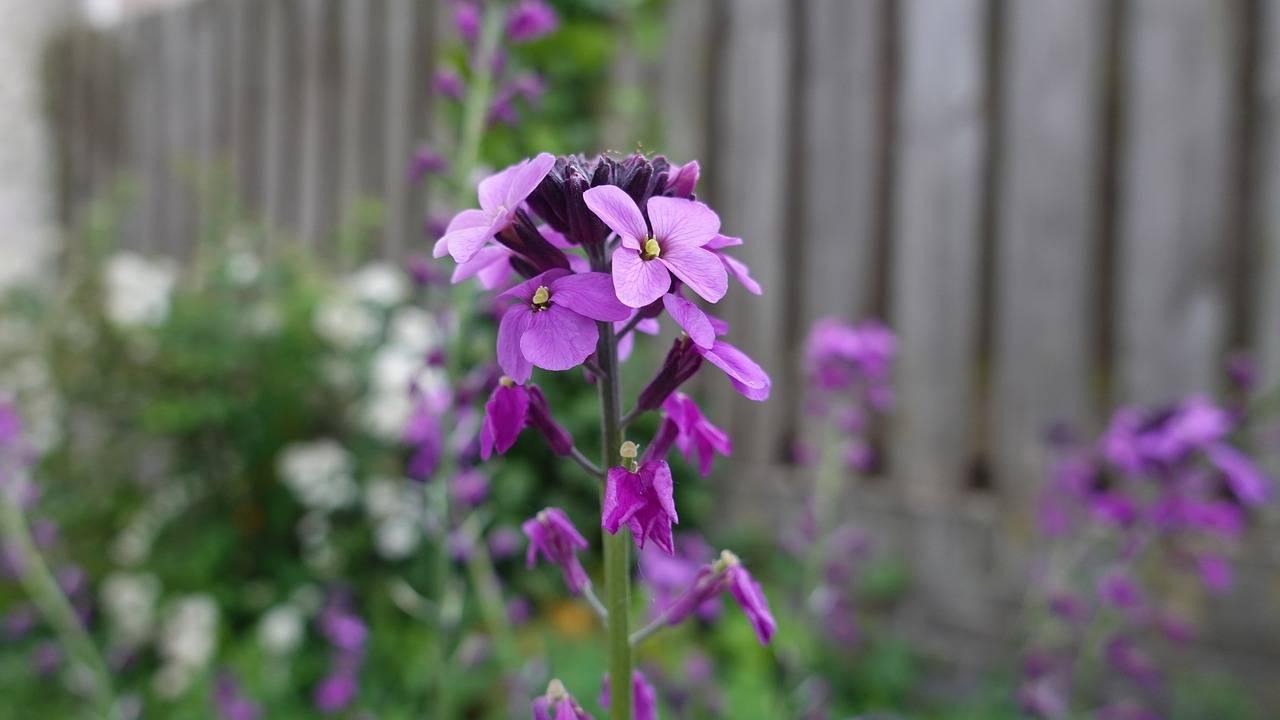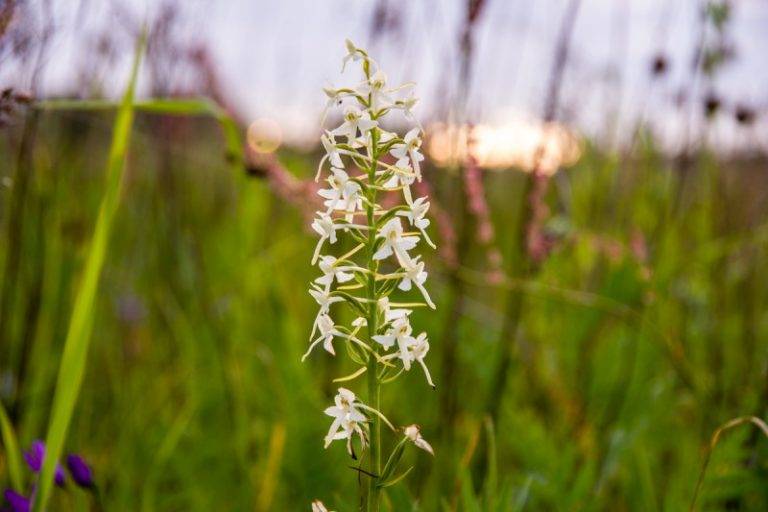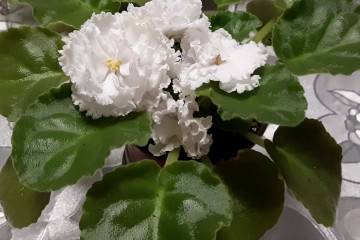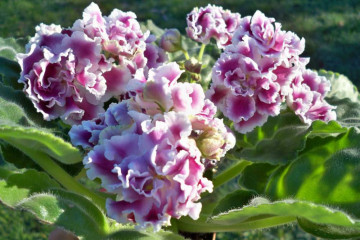Night violet - description and varieties
Content:
Night violet is a familiar name, which is not a standard violet in the understanding of many. This is not a houseplant, it has little in common with ordinary saintpaulia. Planted on flower beds and borders, the evening violet can surprise any grower. How exactly is described below in the article.
What does a night violet (mattiola) look like
Night violet has a scientific name - bifacial lyubka and belongs to a group of biennial or perennial medicinal plants. It is also called hesperis, the matron's nocturnal, wild balsam, cuckoo tears, haystack, forest fracture. But many growers most often call it matthiola.
A short description of what a night violet looks like:
- the plant belongs to the Cabbage family, belongs to the dicotyledonous class;
- when planted in open ground in the first year does not produce flowers. The plant itself reaches a height of 0.5 to 1 m;
- the stems are slightly fleecy;
- leaves are narrow, pointed at the base. Their length is about 12 cm, while their width is only 4 cm;
- flowers are small, 4-lobed. Large ones are observed only in artificially grown ones. The length of the inflorescences reaches 30 cm;
- their shade is usually light, but can range from white to pale lilac or pink.
- there are perennials that can bloom quite unusually compared to the standard night violet flower. There are also hybrids in which not simple flowers predominate, but double ones;
- a significant difference between the night violet is that it has a pronounced smell, which is felt not only in the immediate vicinity of the plant, but also fills the adjacent space. It manifests itself especially strongly in the evening after sunset. In this regard, this plant has no analogues among decorative flowering crops.
Briefly about the history of appearance
This plant prefers to grow in mixed forests, bushes, forest edges or hills. Mainly grows as single specimens, that is, scattered, does not form crowded plantings.
The prevalence from Europe to Asia made the flower popular for growing in flower beds and balconies. This happened because of the wonderful aroma that fills the space. In addition, the appearance of the plant is so elegant, delicate and sophisticated that it is used by landscape designers to decorate areas that claim to be natural.
Common varieties
The night violet is a popular flower that comes in several varieties. Therefore, before planting it in a flower bed, you need to decide what effect you want to get. To do this, you can use the following flower subspecies:
- purple matrona has a bright pronounced aroma exuded by flowers of a fairly large size. They gather in cylindrical inflorescences. They are planted as seeds in open ground at the end of spring;
- hesperis Inspiration refers to 2-year-olds with simple flowers collected in a brush. The shades of the petals can be varied. The plant itself reaches a height of no more than 1 m. The aroma is lighter and more delicate;
- The romance has white flowers and a mild aroma, exuding only in the evening and at night;
- crimson nocturnal matron is the most common species. She has bright crimson flowers, chaotically growing on branched stems;
- Night beauty. Delicate lilac shades are collected in large inflorescences. But the shrub is less tall, only 60 cm maximum under favorable growing conditions. Gardeners often prefer this variety because it is hardy and easily resists a variety of diseases and parasites. Used for landing on personal plots and decorating balconies.
Flower features
The size of the plant ranges from 0.5 m to 1 m. The bushes are of medium spreading, the branches rush upward along with the peduncles.
Color
The color of the leaves and stems is grayish-green. Sometimes it has a slight bluish pubescence.
The color of the petals varies depending on the cultivar, but is always in the range from white to pale pink, from pink to purple, from pale blue to blue. There is also a crimson color.
Flowering time
Mattiola (Mattiol, night violet) is most often found in the garden. Distinguish between levkoy and two-horned. The flowers of the bicorn are very nondescript and small, but they are planted exclusively to obtain a gentle background and a pleasant smell in the evening.
But mattiola levkoy is planted for a decorative appearance. In the daytime, the buds of these flowers are open. Their diameter is quite large, they are bright and varied in color. Petals can be not only simple, but also double, which gives higher decorative properties. In terms of aroma, this variety is much inferior to the two-horned species.
Habitat
Cultivation of matthiola is possible in Central Russia and southern regions, from the European part to Siberia. But these plants feel best in the foothills of the Caucasus and on flat areas.
The progenitor of decorative varieties of night violets is two-leaved lyubka. She is undersized and most often reaches 30-40 cm in height. Its peculiarity lies in the fact that it has 2 tubers that are not divided among themselves. Every year a new replacing tuber appears. Two leaves are formed at the base. At the end of the ejected arrow, a brush of pale colors is formed.
An interesting fact is that this plant is medicinal. For medicinal purposes, tubers are used, which contain glycosides and mucus, as well as starch and sugar. But it is the mucus, which is called salepa, that has a beneficial effect on the digestive tract, providing an analgesic effect. In addition, the plant is used for poisoning, abscess, inflammation of the bladder, nervous exhaustion, inflammation and non-healing wounds.
Planting and grooming recommendations
In order for the night violet to grow and develop well, bloom for a long period of time and delight its owners, it is necessary to provide it with appropriate care conditions. It is important to find a suitable place for her.
Soil, illumination, degree of moisture
It is necessary to take into account the following requirements for this flower to grow conditions:
- provide enough sun. Although the violet will feel good in partial shade;
- acidic soils are poorly tolerated;
- the optimal type of soil is loamy and fertile;
- it is advisable to prepare the ground in the fall. To do this, it is necessary to dig up the area, applying organic fertilizers.
Night violet is quite unpretentious. But, since the plant does not tolerate heat, it is necessary to provide good abundant watering, especially in the middle of summer.
But, if mattiola is planted ahead of schedule, then you should not worry that the shoots may suffer from night frosts. Lyubka is a frost-resistant plant.
Pest prevention
Most often, the night violet is exposed to the following diseases and parasites:
- fleas. Against them, it is necessary to dust the bushes with ash or tobacco dust. A tincture of horse sorrel, which must be sprayed with plants, has proven itself well;
- keela is a fungal disease that can be avoided by planting matthiola after cruciferous plants. Otherwise, when the bushes are infected, they are removed and burned. The soil is treated with chemicals or lime;
- caterpillars of butterflies are capable of infecting greens, thereby undermining the plant's immunity. They need to be picked by hand or used with insecticides.
Can I plant indoors
In closed rooms (at home), matthiola is not planted. These flowers can be used to decorate the facade of a house by placing them in hanging pots or large flowerpots, which can also be displayed on balconies.
Breeding features
It is best to plant matthiola in open ground with seeds. To do this, it is necessary to select a period when the threat of recurrent night frosts has already passed. Most often sown from April to May, taking into account the region.
The holes are prepared, the distance between the bushes is kept about 15-20 cm. From 3 to 6 seeds are laid in each hole.
When the first shoots appear (after about 7 days), you need to remove the weakest ones.
Night violets will bloom in about 25-40 days.
If planting in open ground is not suitable, then you can plant seeds for seedlings in peat-distilled cups. This is done in February. The planting material is placed in a cool room with a temperature of up to 15 ° C.
After the emergence of seedlings, the temperature is further reduced. It is desirable that it be no higher than 10 ° C. However, seedlings require a lot of light. This is necessary for the plant to bloom as early as possible in its adult state.
As soon as a couple of leaves appear, the matthiola is dived into the open ground. This happens approximately in May.
Popularity of use in landscape design
In landscape design, the night violet is often used. Moreover, experienced designers form lawns and flower beds in such a way that two different types of mattiola are present on them.One is used to achieve the desired aroma on the site, while the other is used for decorative flowering.
Today there are a large number of different varieties, for example, Starlight, large-flowered, summer, remontant, gigantic, standard, northern, Pure gold, Sapphire, Ruby, Thumbelina, etc., combining which you can effectively decorate a flower bed.
To decorate cities
You can also find decorative species of night violets in city flower beds. The choice of this flower is primarily due to its unpretentiousness and low susceptibility to various diseases.
For decorating private gardens
Also in private gardens, amateur gardeners use this flower to compose beautiful compositions. They use simple or double flowers that bloom in columnar inflorescences. Fortunately, the coloristic variety of petals allows you to choose what you like most.
Adhering to the tips and tricks for choosing and growing a variety, it will be possible to achieve not only an attractive flower bed, but also to create a fragrant atmosphere on the site. The main thing is to know after what you can plant a night violet and how often to water.





















